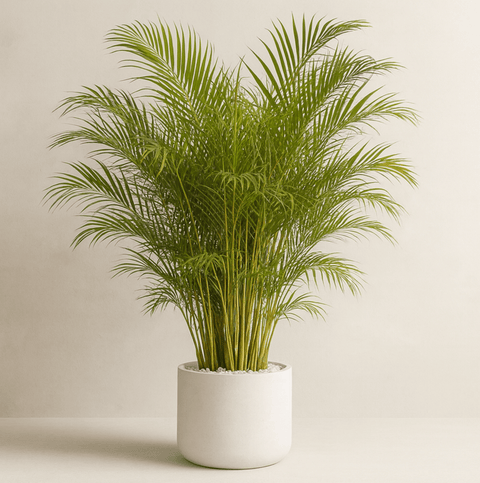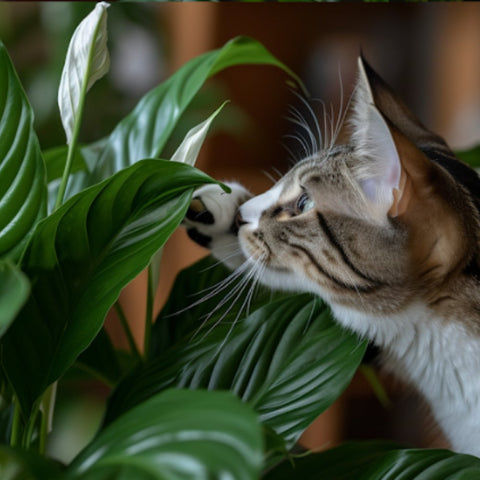Blog Post - Golden Pothos and Cats: Safety Measures
Golden Pothos plants have gained immense popularity over the years as indoor houseplants. Their vibrant green leaves and ease of care make them a favorite among plant enthusiasts. However, it's essential to understand the potential hazards they pose to our beloved pets, especially cats.
What is Golden Pothos?

Golden pothos, scientifically known as Epipremnum aureum, is a tropical plant native to Southeast Asia. It is characterized by its heart-shaped leaves with variegated patterns of yellow or white. These plants are hardy, low-maintenance, and can thrive in various lighting conditions, making them ideal for indoor decoration.
The Benefits of Having Golden Pothos

Aside from their aesthetic appeal, golden pothos plants offer several benefits when kept indoors. They are known to improve indoor air quality by removing toxins such as formaldehyde and benzene. Additionally, their dense foliage can help absorb excess carbon dioxide and release oxygen, contributing to a fresher and healthier living environment.
Moreover, maintaining golden pothos as an indoor plant is relatively easy, requiring minimal watering and occasional pruning. This resilience makes them an attractive choice for both experienced and novice plant owners.
The Popularity of Golden Pothos
Golden pothos plants have soared in popularity among plant enthusiasts and homeowners alike. Their versatility and adaptability to different environments have made them a staple in many households. Whether placed on shelves, hanging baskets, or used in decorative arrangements, golden pothos plants add life and vibrancy to any room.
Golden Pothos and Cats: The Poisonous Connection

Although golden pothos plants are beautiful and beneficial, it's important to be aware that they can be toxic to cats. While the exact mechanism of toxicity is not fully understood, the plant contains certain compounds that can cause harm if ingested or if a cat comes into contact with the leaves or sap.
Understanding the Toxins
Golden pothos contains calcium oxalate crystals, known as raphides. When cats bite or chew on the leaves, the raphides are released, causing irritation and damage to the mouth, throat, and digestive tract. Furthermore, the plant's sap can cause dermatitis or allergic reactions if it comes into contact with a cat's skin.
While not usually life-threatening, ingestion of golden pothos can lead to symptoms ranging from mild discomfort to more severe reactions in cats.
How Cats Come into Contact with Golden Pothos
Cats are naturally curious creatures and may interact with plants around the house, including golden pothos. They may chew on the leaves, play with them, or accidentally knock them over while exploring. Therefore, it's important to take precautions to prevent cats from accessing these potentially hazardous plants.
Symptoms and Risks of Golden Pothos Poisoning in Cats

Recognizing the Symptoms
If a cat ingests or comes into contact with golden pothos, they may exhibit various symptoms, including:
- Vomiting
- Diarrhea
- Excessive drooling
- Mouth and throat irritation
- Difficulty swallowing
- Loss of appetite
- Lethargy
If any of these symptoms occur after a cat has had contact with golden pothos, it's crucial to seek veterinary attention promptly.
Potential Risks
While most cases of golden pothos poisoning in cats result in mild to moderate symptoms, there is still a risk of more severe complications. In some cases, long-term ingestion or exposure to the plant can lead to organ damage, especially in the kidneys.
It's important to remember that every cat may react differently to the toxins, so prompt medical care is vital in ensuring the best outcome for your furry friend.
Preventive Measures and Safety Tips
Protecting Your Cat
To safeguard your cat from potential golden pothos poisoning, consider the following preventive measures:
- Keep golden pothos plants out of reach or in areas that are inaccessible to your cat.
- Consider using hanging baskets or placing plants on high shelves to deter your cat from reaching them.
- Opt for cat-friendly houseplants instead, such as spider plants or Boston ferns, which are safe for feline companions.
A Safe Environment for Cats
Creating a safe environment for your cat involves more than just avoiding toxic plants. Monitor their surroundings for any potential hazards, ensuring that household cleaning products, medications, and other substances are securely stored away. Regularly inspect their toys, scratching posts, and bedding for any signs of wear or damage that could pose a risk.
What to Do if Your Cat Is Exposed to Golden Pothos

If you suspect your cat has ingested golden pothos, it's crucial to take immediate action to minimize the potential harm.
Immediate Steps to Take
- Remove any golden pothos residue from your cat's mouth or skin, using gloves if necessary.
- Offer your cat water to rinse their mouth and dilute any toxins that may have been ingested.
- Observe your cat for any concerning symptoms or behavior changes.
Consulting a Veterinarian
Even if your cat appears fine initially, it's still important to consult a veterinarian for professional advice and guidance. They can assess the situation, provide tailored recommendations, and determine the necessary treatments or interventions.
Conclusion
Golden pothos plants may be visually appealing and offer various benefits as indoor houseplants, but they can be toxic to cats. Understanding the potential risks and taking preventive measures can help protect your feline friend from golden pothos poisoning.
By creating a safe environment and being aware of the hazards posed by certain plants, responsible pet owners can ensure the well-being and health of their furry companions. Remember, your cat's safety should always be a top priority.























Comments (0)
There are no comments for this article. Be the first one to leave a message!